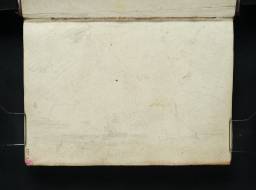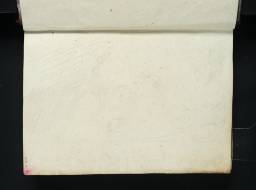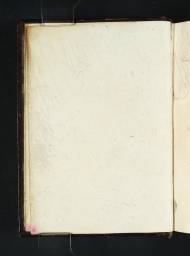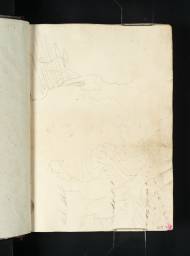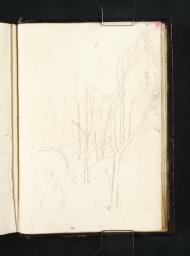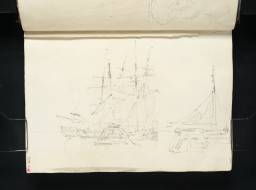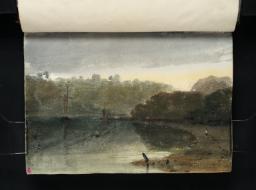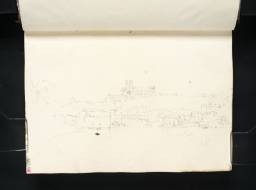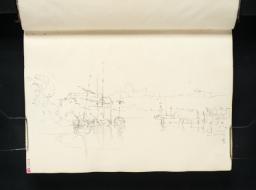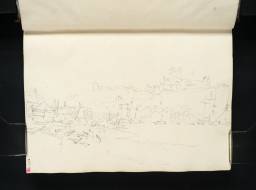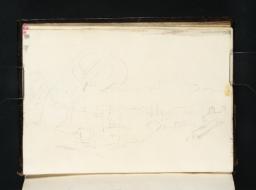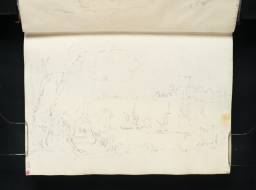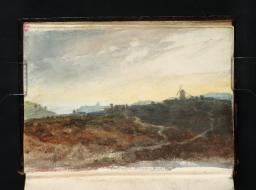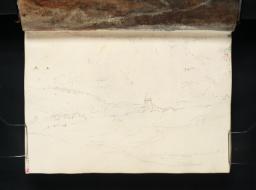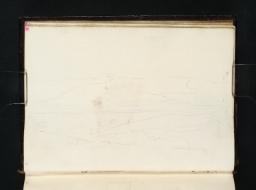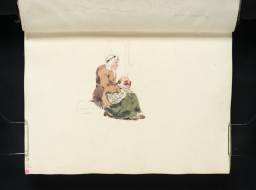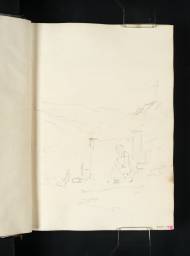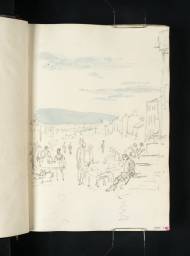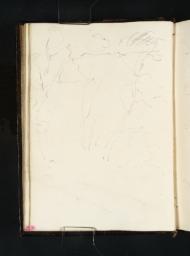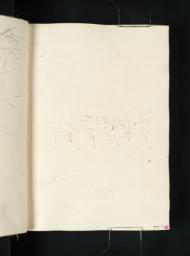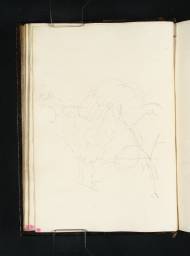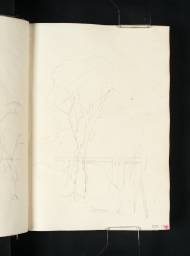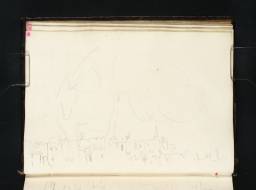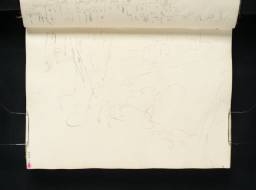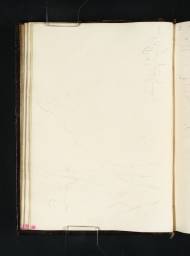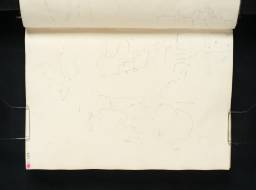Turner Bequest LIII 1–101
Sketchbook bound in boards covered with calf leather, gold–tooled at the edges and spine, with one broken clasp
101 leaves; 97 of white wove paper and 2 flyleaves at each end of bluish–white laid paper; page size 162 x 112 mm; watermark ‘1794 | J Whatman’
Inscribed by Turner in ink ‘70 Helmsley to Newcastle | Northumberd Tweed’ on parchment label on spine (D40775)
Numbered 313 as part of the Turner Schedule in 1854, and endorsed by the Executors of the Turner Bequest, Henry Scott Trimmer, Charles Turner, Charles Lock Eastlake and John Prescott Knight, in ink ‘No 313 Contains 65 | Leaves in Pencil & Colour most on both sides – | H S Trimmer | C Turner’ and in pencil ‘C.L.E.’ and ‘JPK’ inside front cover, towards top
101 leaves; 97 of white wove paper and 2 flyleaves at each end of bluish–white laid paper; page size 162 x 112 mm; watermark ‘1794 | J Whatman’
Inscribed by Turner in ink ‘70 Helmsley to Newcastle | Northumberd Tweed’ on parchment label on spine (D40775)
Numbered 313 as part of the Turner Schedule in 1854, and endorsed by the Executors of the Turner Bequest, Henry Scott Trimmer, Charles Turner, Charles Lock Eastlake and John Prescott Knight, in ink ‘No 313 Contains 65 | Leaves in Pencil & Colour most on both sides – | H S Trimmer | C Turner’ and in pencil ‘C.L.E.’ and ‘JPK’ inside front cover, towards top
Accepted by the nation as part of the Turner Bequest 1856
References
This sketchbook takes its name from Turner’s label on the spine (D40775) but in fact, with one exception noted below, it contains no identified sketches of Helmsley itself, which he studied on his return journey from Scotland in several drawings in the Chester sketchbook (Tate D05076–D05088; Turner Bequest LXXXII 3–13). He was using the book at the same time as the Guisborough Shore and Dunbar sketchbooks (Tate; Turner Bequest LII, LIV); these were the first of a group of eight books that he took with him on his tour to Edinburgh and the Scottish Highlands in July 1801. In the Scotch Lakes sketchbook (Tate; Turner Bequest LVI, inside front cover), Turner noted that on the ‘8 of July left Edinburgh and on the 5 of August finish’d this book at Gretna Green’. Thereafter he made more drawings on his way south in the Chester sketchbook.
The itinerary covered by the Helmsley book includes Rievaulx and Scarborough, and continues up the Yorkshire coast to Whitby, where Turner made several drawings, though a longer sequence of studies at Whitby is in the Dunbar sketchbook (Tate D02746–D02765; Turner Bequest LIV 83a–93). He went on up the coast to Newcastle and Morpeth, and seems to have spent some time in the neighbourhood of the latter, making several studies of its castle gatehouse, and following the course of the River Wansbeck as far as Milford; see folios 38 verso and 39 recto (D02526–D02527). He even perhaps ventured as far east as the coast, where he may have made a view of Newbiggin; see folios 41 verso–42 recto (D02532–D02533).
A study of Brinkburn Priory on folio 34 recto (D02517), corroborated by another extracted from the in the Smaller Fonthill sketchbook (Fogg Museum, Cambridge, Massachusetts), indicates that from Morpeth he travelled north by the inland road via Wooler, rather than the more obvious route through Alnwick, which he had taken in 1797; see the North of England sketchbook (Tate; Turner Bequest XXXIV), which contains drawings of Alnwick, Warkworth and other coastal sites. From Wooler his route took him to Berwick upon Tweed and Norham. After folio 51 recto (D02550) a series of thirteen blank leaves is followed by one more drawing, on folios 65 verso–66 recto (D02565–D02566) that appears to have been made at Norham; thereafter, the regular sequence breaks down and there are studies from different sections of the journey through Northumberland, in no clear order, and apparently made with the book held the other way up.
Several pages at the back end of the book, a few of them containing drawings in watercolour, have been cut out (see the technical notes below); these have not been identified elsewhere in the Turner Bequest. Several new identifications of views here suggest that the topographical sequence in this book is largely random, but it seems possible to deduce further details of Turner’s approach to Edinburgh, from Dirleton, as recorded in the Dunbar sketchbook (Tate D02683, D02684; Turner Bequest LIV 51a, 52), to Roslin in the same book (Tate D02660; Turner Bequest LIV 39a) and Craigmillar on folios 91 verso–92 recto (D02597–D02598) in the present book. Gerald Wilkinson proposed that the Helmsley book belonged to a different, otherwise unrecorded, journey to Edinburgh in the spring of one of these years,1 but there is no evidence for this.
Most of the sketches are slight, though a few are more worked up, and a handful have been developed into expressive watercolour studies. There is one incomplete drawing in pen and brown ink (folios 65 verso–66 recto; D02565–D02566), and, unexpectedly, on folio 3 verso (D02466), a rather stiff copy by someone else, apparently an amateur, of the sketch at Helmsley in the contemporary Chester sketchbook (Tate D05076; Turner Bequest LXXXII 3). Such interventions are extremely rare in Turner’s sketchbooks, which he regarded as confidential sources for his professional activities; there is another, more interesting case in the Studies for Pictures sketchbook (Tate D04133; Turner Bequest LXIX 116). It may be that these additions, in each case the work of an amateur, are evidence of Turner’s involvement with the Danby family at this period of his life.
The compiler is grateful to Henry Potts for help with entries for this book.2
Technical notes
How to cite
Andrew Wilton, ‘Helmsley sketchbook 1801’, sketchbook, May 2013, in David Blayney Brown (ed.), J.M.W. Turner: Sketchbooks, Drawings and Watercolours, Tate Research Publication, April 2016, https://www

